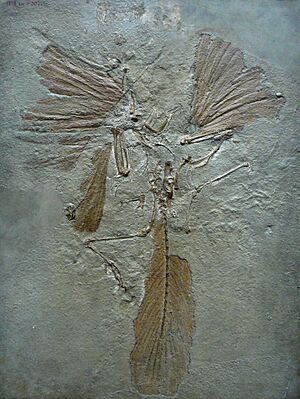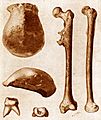Transitional fossil facts for kids
Transitional fossils are like amazing clues from the past! They are the fossilised remains of ancient living things that show features from two different groups. Imagine finding a creature that looks a bit like a dinosaur and a bit like a bird – that's a transitional fossil! A famous example is Archaeopteryx, which shows early bird features but still looks very much like a small dinosaur.

It's interesting that transitional fossils are often rare. This might mean that these new types of living things were not yet very common. Their populations were probably small. Because of this, it would be harder to find their fossils.
For example, in the Solnhofen Limestone where Archaeopteryx was found, there are more fossils of pterosaurs. Pterosaurs were flying reptiles, and they were the main creatures in the sky during the Jurassic period.
But later, in the Lower Cretaceous period, things changed. Pterosaurs started to become less common. Instead, many different kinds of birds appeared. These birds are found in famous fossil sites in China, like the Jehol biota. The birds from the Lower Cretaceous look much more like modern birds. They developed features that helped them live in places or ways that pterosaurs used to, or even in brand new ways.
How Creatures Change: Mosaic Evolution
When we look at transitional fossils, we often see something cool called mosaic evolution. This means that not all parts of a creature change at the same time. Some features might still look old or primitive. Other features, however, are new and more advanced.
With Archaeopteryx, for example, its front legs were very advanced. They clearly show it could fly. Also, its feathers had a special stem (called a rachis) that was off-centre. This is a feature of all bird flight feathers. But the rest of its skeleton was very much like a small meat-eating dinosaur.
So, when one group of animals changes into another, it's not like a sudden, complete makeover. Instead, different parts of their bodies change at different times. This process involves a series of transitional species. We are lucky to find even a few of these in the fossil record!
Images for kids
-
Traditional spindle diagram showing how different groups of vertebrates (animals with backbones) branched off from each other. Transitional fossils are often found near these branching points.
-
Archaeopteryx is one of the most famous transitional fossils. It helps us understand how birds evolved from theropod dinosaurs.
-
A. afarensis - a famous early human ancestor, showing how it walked upright.
-
Tiktaalik roseae had spiracles (small holes for breathing) above its eyes. This fish-like creature had features that hint at how animals moved from water to land.
-
Modern flatfish are unusual because both of their eyes are on the same side of their head.
-
The Devonian fossil plant Runcaria looks like an early seed. However, it didn't have a hard seed coat or a way to guide pollen like modern seeds.
-
A historic drawing from 1904 showing what Archæopteryx might have looked like.
-
"Java Man" or Pithecanthropus erectus (now called Homo erectus). This was an early human ancestor found in Java in 1891–92.
See also
 In Spanish: Forma transicional para niños
In Spanish: Forma transicional para niños







